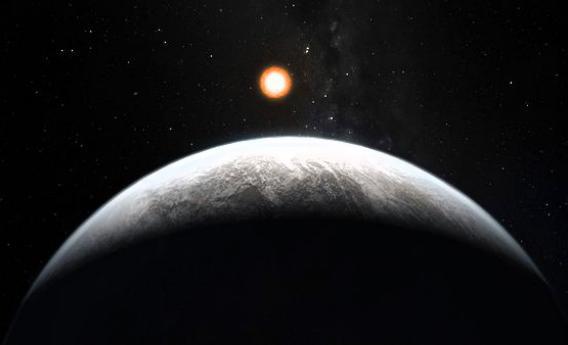On Jan. 15, 1992, an astronomer named Andrew Lyne stood up in front of several hundred colleagues at a conference in Atlanta to admit that he’d screwed up. Six months earlier, Lyne, of the University of Manchester, United Kingdom, had announced the discovery of something that seemed impossible. He had found evidence of a planet orbiting a pulsar—the burned-out husk of a star that had exploded as a supernova, a blast so violent that for a few days, it had literally outshone an entire galaxy.
It seemed crazy—how could a planet survive an explosion like that? But after an exhaustive series of checks to rule out any mistakes, Lyne and two colleagues published a paper in the journal Nature, and he was invited to give a talk at the American Astronomical Society meeting the following January. Then one night, a few weeks before the talk, Lyne realized to his horror that he’d failed to do one simple but crucial calculation—he hadn’t allowed for the fact that Earth’s orbit is elliptical rather than perfectly circular. When he made the correction, he told me a few years later, still smarting from the mistake, “the planet disappeared.”
What saved Lyne from something worse than mere embarrassment was the fact that he discovered the error himself and that he went public right away about being wrong.
It doesn’t always happen this way. False discoveries happen surprisingly often in science, and while many are due to outright fraud, plenty come about because scientists fail to rule out alternate, usually more prosaic explanations for what they think they’ve found. “The first principle [of science] is that you must not fool yourself,” the physicist Richard Feynman said in his 1974 Caltech commencement address, “and you are the easiest person to fool.”
This turns out to be especially true in astrobiology, the search for planets and life beyond our own solar system (and the topic of my new book Mirror Earth). The field is littered with evidence of extra-solar worlds or alien life that have vanished, on closer inspection, just like Lyne’s planet.
There’s a right way to be wrong and a wrong way to be wrong. When Lyne finished his mea culpa, a ballroom full of astronomers erupted into a standing ovation. He’d screwed up, but he caught his mistake and came clean. It was “the most honorable thing I’ve ever seen,” the late John Bahcall, an astrophysicist at the Institute for Advanced Study told me at the time. “A good scientist is ruthlessly honest with him- or herself, and that’s what you’ve just witnessed.”
Others haven’t been so forthcoming. Take Peter van de Kamp, an astronomer at Swarthmore College. In the early 1960s, he announced that he’d found evidence of a planet orbiting Barnard’s Star. The discovery went unquestioned, and even made it into some textbooks, before being debunked by astronomer George Gatewood of Allegheny Observatory in 1973.
What van de Kamp thought was a planet was actually a glitch caused when his telescope’s lens was remounted. It was an honest if sloppy mistake—but van de Kamp never admitted it, and his reputation suffered badly as a result. (After many false sightings, the first confirmed planet around a sun-like star was announced in 1995.)
Or take the fabulous claim in 1996 that evidence of fossilized bacteria had been found inside a Martian meteorite. The discovery of life on Mars, extinct or not, was front-page news, naturally enough. Over the next few years, however, other scientists chipped away at this evidence until the astrobiology concluded it simply didn’t add up. NASA scientist David McKay and his colleagues are still sticking to their guns, more than 16 year later, however, which has left them marginalized in the scientific community.
Then there was the discovery in 2010 that a bacterium from Mono Lake in California could take up arsenic into its DNA in place of the normal phosphorus. This seemed to imply that life can arise under a wider variety of conditions than biologists thought, boosting the chances that aliens might exist somewhere out there in the Milky Way.
Again, though, independent scientists took a look couldn’t replicate the original findings. They concluded that the claim of arsenic-based life was wrong. But John Tainer, a Lawrence Berkeley National Laboratory researcher who is still working on the bacterium, isn’t deterred. “There are many reasons not to find things,” he told the Washington Post. “I don’t find my keys some mornings. That doesn’t mean they don’t exist. The absence of a finding is not definitive.”
The list goes on, and as the search for a truly Earth-like planet heats up, thanks largely to the wildly successful Kepler Space Mission, the race to be first to find one has led to at least one more questionable discovery—a planet known as Gliese 581g, which co-discoverer Steve Vogt described as “a place where life has a lot of chances of having a foothold.”
Except that most experts in the field think Gliese 581g doesn’t exist. “I suspect that the analysis was not done as carefully as it could have been,” Eric Ford, an astronomer at the University of Florida told me for my chapter on the controversy in Mirror Earth. “I was skeptical as soon as I read it.” In short, Vogt and his collaborator Paul Butler may have screwed up.
But like the other scientists whose discoveries have been widely rejected by their colleagues, Butler and Vogt continue to insist that their planet is really there. And it’s not enhancing their otherwise excellent reputations. When the first true twin of Earth is finally discovered—and it could happen literally any day now—you can be sure that whichever research team finds it has put enormous effort into making sure they aren’t fooling themselves.
